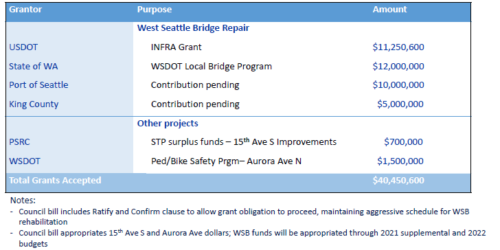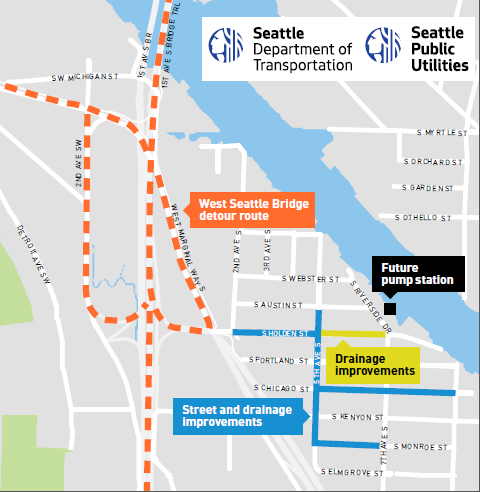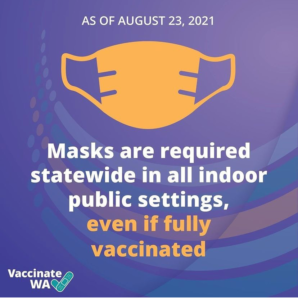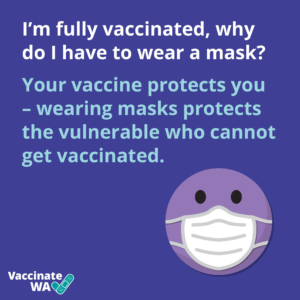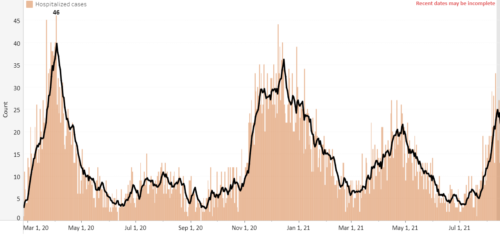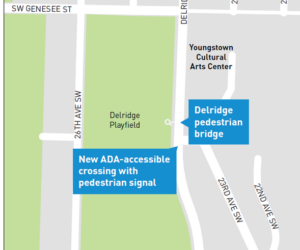West Seattle Bridge Funding Update // Mask Up Indoors Starting Monday // Delridge Pedestrian Bridge/Survey Open through August 30 // Finance Committee Action on Mid-year Budget Including SPD // Less Lethal Weapons’ Regulation // Revenue Forecast
West Seattle Bridge Funding Update
On Wednesday, the Transportation and Utilities Committee approved legislation accepting grants to SDOT for transportation projects. The legislation now moves to the Full Council for a final vote.
Included are four grants related to the West Seattle Bridge. Two of these grants have been announced before:
- $11.26 million INFRA grant
- $12 million from WSDOT for federal grant bridge funds
This brings total federal grant funding to $37 million, approximately 70% of the full repair cost.
Two grants included in the legislation are new. The legislation gives authority to accept grants of up to:
- $10 million from the Port of Seattle, and
- $5 million from King County
Negotiations are still active with the Port and King County; consequently, agreements are not yet completed. The Council granted approval in advance in order to maintain the schedule. The legislation also accepts grants for 15th Avenue South and Aurora Avenue North:
Last week’s newsletter mentioned the South Park Drainage and Roadway Partnership Project; here’s an updated map showing where street and drainage improvements are taking place:
Mask Up Indoors Starting Monday
I know this isn’t news any of us want to hear. But masks are back. They are a necessary tool in stopping the spread of the COVID-19 delta variant. Please wear your mask when indoors in a public setting to protect the health of everyone.
Esto es algo que nadie quiere escuchar, pero debemos usar máscaras de nuevo. Son una herramienta importante para detener la propagación de la variante delta de COVID-19 y las necesitamos ahora mismo. Usa tu máscara cuando estés en un lugar público cerrado para proteger a todos.
The statewide indoor mask mandate starts on Monday, August 23rd. The order requires face masks for everyone over five years of age in most public indoor settings, regardless of vaccination status. These include places like grocery stores, malls, gyms, and community centers. Masks are strongly recommended in crowded outdoor settings like sporting events, fairs, and concerts where physical distancing is not possible. You can learn more here.
Vaccination Is Our Most Important Tool
Healthcare system strained: Ultimately, increasing vaccinations is our best bet to reduce the spread of COVID-19 locally. The health care system is under immense strain right now, due in part to increased COVID-19 transmission, mostly among unvaccinated people. Between February and August in our state, 94.5% of people hospitalized for COVID-19 were not fully vaccinated.
On Thursday, Washington State Hospital Association reported that hospitalizations from COVID-19 are the highest they’ve ever been. 1,100 people were hospitalized with COVID statewide during the peak last December. On Thursday morning, there were 1,240. Hospitalizations are also increasing in younger ages, notably 20-29 and 30-39. Here are King County COVID hospitalizations:
Protections for workers: My office has been hearing from restaurant and bar owners and workers who are concerned about worker safety, as employees are constantly in contact with unmasked customers who may or may not be vaccinated. Currently, individual business owners can choose to require vaccination for customers, and many are doing so. Workers are on the front lines of enforcement without the re-enforcement that a government mandate can provide when engaging with customers about vaccine status. Facing a significant staffing shortage to begin with, they are calling for action to require vaccination for employees and customers, so they can assure a safe working environment – similar to vaccine requirements in San Francisco and New York City.
I have been in contact with Public Health – Seattle & King County and the Mayor’s Office regarding this request, and I continue to be interested in hearing from workers about the best way to secure their safety. I am also hearing clearly that everyone is eager to do whatever it takes to keep people employed by avoiding more capacity restrictions or another shutdown for the industry.
Get vaxed and help others get vaxed: Meanwhile, please get vaxed if you’re not already, and encourage your loved ones to do the same. A higher level of vaccination is truly the only way we can emerge from pandemic restrictions.
- Enter your zip code to find convenient vaccine shots at Vaccinate WA.
- For in-language assistance scheduling a vaccination, call one of the Vaccine Community Helplines.
- Check out this map, which shows District 1 vaccine providers
- Look for vaccine popup clinics near you.
Free rides to and from your vaccination are offered by Lyft and Hopelink Mobility (phone: 425-943-6706).
Free childcare is available for vaccination appointments and recuperation from KinderCare (phone: 1-866-337-3105), the Learning Care Group (phone: 1-833-459-3557), and the YMCA (contact your local YMCA to learn more).
Delridge Pedestrian Bridge/Survey Open through August 30
As part of the Delridge Way SW – RapidRide H Line project, SDOT is installing a new, accessible crossing on Delridge Way SW at the intersection with SW Oregon Street.
They are evaluating whether to remove or repair (seismic retrofit) the nearby pedestrian bridge connecting the Youngstown Cultural Center and the Delridge Playfield.
SDOT’s website has a description of the options.
SDOT will be at the Delridge Community Center to discuss the proposal on:
- Friday, August 27 from 2 to 4 p.m.
- Sunday, August 29 from 1 to 3 p.m.
You can also e-mail delridgetransit@seattle.gov and call 206-775-8739.
Here are links to the survey:
- English – https://forms.office.com/g/D9UtM12yBZ
- 한국어 – https://forms.office.com/g/rGrhJ7LaTT
- Tagalog – https://forms.office.com/g/Gaii8M7Qv8
- Español – https://forms.office.com/g/ZhavXJiXLC
- Tiếng Việt – https://forms.office.com/g/tpxXNXbCHX
Finance Committee Action on Mid-Year Budget Including SPD
In September, the Council will be considering the mid-year supplemental adjustment to the 2021 adopted budget, as recommended by the Finance and Housing Committee on Tuesday. This legislation includes changes to the SPD budget that I proposed, made possible by an estimated $15 million not needed for officer salaries this year. I first proposed these investments in May, which unfortunately did not pass. The supplemental budget proposal in the Finance and Housing committee represented another opportunity.
I proposed – and committee members approved – significant changes to the budget legislation to ameliorate the community safety impacts associated with the current shortage of police officers. The shortage of sworn officers is resulting in significantly reduced 911 “priority one” responses – responses that have a standard goal of 7 minutes. It’s important that we make investments to address the real workload challenges for those sworn officers who remain on as public servants in Seattle.
My amendments also added funding for civilian positions, technology investments, a new training program, and alternatives to an armed response to build community safety. Together, these amendments reflected the priorities of SPD, community safety advocates, the Mayor’s Office, and Council’s work to reimagine public safety and provide alternatives to an armed response, while ensuring officers have the ability to respond to calls that only they are qualified to do.
The successful new amendment, proposed with Finance & Housing Chair CM Mosqueda, includes funding for:
- Community Service Officers and Crime Prevention coordinators;
- Hiring process accelerators for both sworn officers and civilian hires;
- National Institute for Criminal Justice Reform 911 call data analysis to support re-imaging policing;
- Work, Scheduling and Timekeeping project updating and modernizing SPD’s management of overtime and addressing the recommendations made by the City Auditor in 2016, and recommendations made recently the Office of Police Accountability;
- $1.5 million for overtime. SPD requested $3 million. Both the Mayor and Council proposed reductions in the overtime budget last fall for 2021, assuming fewer large events would occur due to COVID. With additional events now taking place, more overtime funding may be needed, as well as for patrol 911 response.
- Evidence storage space, as recommended by the Inspector General;
- Funding for additional Public Disclosure work, as recommended by the City Auditor.
The amendment also incorporates priorities I announced in my Public Safety and Human Services committee in late July. The Mayor and SPD also stated support for these investments to re-direct a total of $1.5 million from the SPD budget to other departments.
- Community Safety and Communications Center funding for a protocol system for 911 dispatchers; this is critical for ensuring 911 call takers have the training to ensure the best response, as we embrace alternatives. Similar to what Seattle Fire uses in its dispatch center, the protocol system will implement a more consistent process for obtaining key information from 911 callers and support better data analysis to plan for resource deployment, including alternatives to police response. I didn’t want to wait until the Mayor made a 2022 budget recommendation to begin providing funding for this effort.
- Regional Peacekeepers’ Collective funding to prevent gun violence. This is critically important right now. Community violence intervention programs such as the Regional Peacekeepers Collective have been shown to reduce violence by as much as 60%. I didn’t want to wait until the Mayor made a 2022 budget recommendation to begin providing funding for this effort.
- Funding for Triage One; to redirect 911 calls as a result of the National Institute for Criminal Justice Reform call analysis commissioned by SPD; they are calls that do not require a first response from sworn officers, and reduce the need for them to respond to these calls. I didn’t want to wait until the Mayor made a 2022 budget recommendation to begin providing funding for this effort.
Our amendment also includes an investment of $3 million in the Seattle Community Safety Initiative, to fund additional alternatives to policing. HSD recently awarded contracts to 33 of the 70 applicants; additional funds could fund additional projects, or extend the funding from 18 to 24 months.
I also proposed a separate amendment to fund $2.25 million for necessary SPD technology investments, which passed. It includes funding for Data Analytics Platform; for Capacity Planning Tool; Innovation Blueprint; and Officer Wellness and Supervision (which is a new version of this). Some of these are required by the Consent Decree.
The Data Analytics Platform will be used to monitor staffing and overtime, analytical processes necessary for reimagining policing such as 911 alternatives, next generation early intervention, and to monitor disparate impacts. The Capacity Planning Tool will evaluate staffing demand, and calculate staffing requirements based on scenarios such as 911 alternate response, and expands resource planning beyond core functions such as patrol and investigations to include support for functions such as force review and public disclosure. Innovation Blueprint includes identifying strategies and online tools to increase transparency and improve police practices. Officer Wellness and Supervision include more accurate statistical models for predicting and guiding interventions for employees exhibiting signs they need support, as part of the department employee wellness and retention strategy.
I strongly support Chief Diaz’s efforts to innovate in developing a training curriculum to ensure SPD recruits understand community expectations for a public service career in law enforcement in Seattle. That’s why I successfully proposed funding for a program Chief Diaz is initiating to support Seattle-specific training for new officer recruits before they go to the state training academy. The program is being developed under the guidance of a long-time educator, and consists of a 45-day program that “pulls recruits out of traditional classroom training and immerses them in community-based, peer-based, and introspective experiences that will provide them both a lens through which to receive their BLEA (I.e. academy) training and a foundation upon which to build their careers as Seattle Police Officers.” Most of this work will take place in the community. The curriculum strives to implement the principles of relational policing, as recommended by the Inspector General Sentinel Event Review.
Less Lethal Weapons’ Regulation
On Monday, the Council voted 7-0 to adopt legislation that I sponsored to restrict the use of less lethal weapons, principally during demonstrations.
There are currently no restrictions on the use of less lethal weapons in Seattle law.
After the Public Safety and Human Services Committee voted 4-1 to pass the legislation in July, I moved to delay the Full Council vote until after a Status Conference for the Consent Decree was held in early August. It was important to wait in case the court wanted to comment on the legislation before the Council passed it. Court approval of the SPD policies that will derive from the new law is necessary, per the scope of the Consent Decree, which includes all laws, policies, and practices that relate to use of force. The legislation was not discussed at the Status Conference.
The legislation includes a full ban on acoustic weapons, directed energy weapons, blast balls, ultrasonic cannons and water cannons. Use of Noise-Flash Devices (Flash Bangs) are banned in demonstrations.
The bill permits the use of pepper spray and pepper ball launchers only in those cases when the “risk of serious bodily injury from violent actions outweighs risk of harm to bystanders.” If used to control crowds another condition must be in place, that there is a “violent public disturbance. The legislation defines when a “violent public disturbance” is taking place. Tear gas use is restrained by 5 separate conditions.
In developing the legislation, Council President Gonzalez and I met with the Consent Decree Monitor and the Department of Justice, to get their informal feedback in advance, with the understanding formal feedback will follow after SPD policies based upon the ordinance are developed and filed with the Court.
You may recall that my PSHS committee first acted in February to recommend a draft bill that was used for those discussions
During conversations about the draft bill, DOJ expressed concern about the potential that restricting the use of certain less-lethal tools in crowd management circumstances could actually lead to officers using higher levels of force, putting both assaultive protestors and the surrounding non-violent protestors at higher risk of harm. Judge Robart expressed similar concerns. DOJ likewise inquired as to whether the draft bill will provide time for relevant SPD officers to be trained to changes in policy, again, to avoid the unwanted impact of having untrained officers resort to higher levels of force than necessary. Judge Robart also raised this issue.
To address these concerns, we added a definition of “crowd control,” and added a 60 day training period. To address concern that officers should have some less lethal option to intervene when property damage is occurring but there is no risk of serious bodily injury, the legislation is silent on and does not regulate the use of non-chemical launchers, e.g. of bean bags or rubber bullets.
Another update allows for use of pepper ball launchers in, a demonstration or rally, but not for crowd control purposes, and only when the “risk of serious bodily injury from violent actions outweighs the risk of harm to bystanders.”
This change is in response to prior judicial decisions; Judge Robart specifically approved policies authorizing use of pepper ball launchers in late February, as part of SPD’s court-mandated annual update to use of force policies
Development of this legislation began after Council’s passage of legislation sponsored by CM Sawant in June 2020 to fully ban the use of most less lethal weapons for crowd control, after demonstrations in Seattle after the murder of George Floyd. Judge Robart issued a restraining order on that bill in July of last year. It never went into effect. In August pf 2020, the Community Police Commission, the Office of the Inspector General, and the Office of Police Accountability made recommendations for how to change the law. These recommendations were sent to Council and Judge Robart, as he requested them as well.
The Public Safety and Human Services Committee has met seven times about this legislation, and heard extensive public comment.
While some criticize the bill as too weak and others say the Council shouldn’t legislate less lethal weapons regulations at all, my goal has been to adopt the strongest regulations possible, building on the August 2020 consensus recommendations of the three accountability bodies, while adhering to the obligations under the Consent Decree.
The CPC stated support for this legislation, while noting their perspective that they believe more needs to be done:
“The Seattle Community Police Commission writes today to offer its support for Council Bill 120105. The Commission believes that the bill’s inclusion of clear delineations of when less-lethal weapons can and cannot be used—and limitations on who can use them—is a significant first step in ensuring the safety of community members when they engage in First Amendment protected protests.
The Commission wishes to note that while we appreciate the improvements the bill would make to Seattle Police Department’s use of crowd control weapons, the Commission wants to ensure that the City Council does not forget that there is more work to be done. This legislation does work toward implementation of some recommendations made by the CPC last fall. However, those CPC’s recommendations identified additional changes necessary to best protect our community’s safety and civil liberties during protests for which we ask the City Council to not stop striving towards.
Now that the Council has voted to adopt the legislation, this is what happens next:
- First, SPD will draft policy revisions within 60 days (provided by Section 4 of the bill)
- Second, DOJ and the Monitor will review the policy revisions (this is when their formal review under the Consent Decree takes place)
- Third, the Court will review the policy revisions (also required by the Consent Decree)
- Fourth, if the Court approves the policy revisions, then the revised policies and the substantive provisions of the bill will take effect (provided by Section 5 of the bill)
Revenue Forecast
On Tuesday the City Budget Office shared an updated August revenue forecast for 2021 and 2022. Here’s a link to the presentation.
The forecast projects an additional $53 million increase in general fund revenues during 2021, and an additional $29 million in 2022, compared to the April forecast.
Sales tax and B&O revenue has come in at rates above the April forecast.
The forecast notes potential risks, including the rising number of cases due to the Delta variant; whether consumers delay returning to pre-pandemic spending patterns; inflation, supply-chain disruptions, shortage of available workers, and potential global drop in demand due to virus surges.
Welcoming Refugees from Afghanistan
It’s been heartbreaking to watch the news from Afghanistan this week, amid reports and images of allies left behind and families here in Seattle concerned for their loved ones. It’s at moments like these that Seattle must live up to being a Welcoming City and find ways to support the refugees who will be resettled here. The Council President’s office has been in touch with state and federal partners about actions Council can take to help.
Since August 1st, 160 refugees from Afghanistan have arrived in the US, primarily landing here in King County. More are expected. The local International Rescue Committee is one of five organizations locally that are helping refugees settle here as they arrive, and they offer this list of ways to help. ReWA is also offering mental health counseling sessions for refugees as they arrive, and shares this information and ways to help their efforts.
River City Skate Park Opening
This Sunday the community will be celebrating the opening of the new River City Skate Park. Tours of the new plaza will happen between 12pm and 2pm and Skate Like a Girl will also have a table there with some giveaways, raffles, music and art.
Youth Member Seats to Join the WRIA 9 Watershed Ecosystem Forum for Salmon Recovery
The Watershed Resource Inventory Area (WRIA) 9 is looking for a youth member to join the forum.
The youth member will serve as an equal member of the Watershed Ecosystem Forum working on projects and policies related to salmon recovery in the Green/Duwamish and Central Puget Sound Watershed. The work is focused on improving habitat, water quality, reducing flood hazards, and increasing the function and health of the watershed and its communities.
Membership criteria:
- Applicants must live or attend school within the WRIA 9 watershed (Enumclaw, Tahoma, Auburn, Kent, Federal Way, Renton, Highline, Vashon, and Seattle).
- Applicants must be between the grades of 9 and 12
- One year terms
- All applicants will be considered regardless of race, color, gender, national origin, or ability.
- Applicants under 18 must have parent permission to serve.
If this sounds like an opportunity you’re interested in, please apply here. Applications are due September 13th.
No Newsletter Next Two Weeks
The City Council is on its summer recess for the next two weeks, and there won’t be any Council meetings during that time. My next update will be in September.
Posted: August 23rd, 2021 under Councilmember Herbold, COVID-19, Education, Human Services, Office of Police Accountability, Police Department, Public Health, Transportation, West Seattle Bridge
Tags: Bridge, District 1, SDOT, transit, West Seattle, West Seattle Bridge

